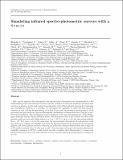Por favor, use este identificador para citar o enlazar a este item:
http://hdl.handle.net/10261/261027COMPARTIR / EXPORTAR:
 SHARE SHARE
 CORE
BASE CORE
BASE
|
|
| Visualizar otros formatos: MARC | Dublin Core | RDF | ORE | MODS | METS | DIDL | DATACITE | |

| Título: | Simulating infrared spectro-photometric surveys with a SPRITZ |
Autor: | Bisigello, Laura; Gruppioni, Carlotta; Calura, Francesco; Feltre, A.; Pozzi, Francesca; Vignali, Cristian; Barchiesi, L.; Rodighiero, Giulia; Negrello, Mattia; Carrera, Francisco J. CSIC ORCID CVN ; Dasyra, K.M.; Fernández-Ontiveros, Juan Antonio; Giard, M.; Hatziminaoglou, Evanthia; Kaneda, Hidehiro; Lusso, E.; Pereira-Santaella, Miguel CSIC ORCID; Pérez-González, Pablo G. CSIC ORCID; Ricci, C.; Schaerer, Daniel; Spinoglio, Luigi; Wang, Lingyu | Fecha de publicación: | 2021 | Editor: | Cambridge University Press | Citación: | Publications of the Astronomical Society of Australia 38: e064 (2021) | Resumen: | Mid- and far-infrared (IR) photometric and spectroscopic observations are fundamental to a full understanding of the dust-obscured Universe and the evolution of both star formation and black hole accretion in galaxies. In this work, using the specifications of the SPace Infrared telescope for Cosmology and Astrophysics (SPICA) as a baseline, we investigate the capability to study the dust-obscured Universe of mid- and far-IR photometry at 34 and 70 µm and low-resolution spectroscopy at 17−36 µm using the state-of-the-art SpectroPhotometric Realisations of Infrared-selected Targets at all-z (SPRITZ) simulation. This investigation is also compared to the expected performance of the Origins Space Telescope and the Galaxy Evolution Probe. The photometric view of the Universe of a SPICA-like mission could cover not only bright objects (e.g. LIR > 1012 L) up to z = 10, but also normal galaxies (LIR < 1011 L) up to z ∼ 4. At the same time, the spectroscopic observations of such mission could also allow us to estimate the redshifts and study the physical properties for thousands of star-forming galaxies and active galactic nuclei by observing the polycyclic aromatic hydrocarbons and a large set of IR nebular emission lines. In this way, a cold, 2.5-m size space telescope with spectro-photometric capability analogous to SPICA, could provide us with a complete three-dimensional (i.e. images and integrated spectra) view of the dust-obscured Universe and the physics governing galaxy evolution up to z ∼ 4. | Descripción: | arXiv:2111.11453v1 | Versión del editor: | https://doi.org/10.1017/pasa.2021.57 | URI: | http://hdl.handle.net/10261/261027 | DOI: | 10.1017/pasa.2021.57 | E-ISSN: | 1448-6083 |
| Aparece en las colecciones: | (IFCA) Artículos (CAB) Artículos |
Ficheros en este ítem:
| Fichero | Descripción | Tamaño | Formato | |
|---|---|---|---|---|
| simulaspritz.pdf | 8,47 MB | Adobe PDF |  Visualizar/Abrir |
CORE Recommender
Page view(s)
47
checked on 16-may-2024
Download(s)
36
checked on 16-may-2024
Google ScholarTM
Check
Altmetric
Altmetric
NOTA: Los ítems de Digital.CSIC están protegidos por copyright, con todos los derechos reservados, a menos que se indique lo contrario.
